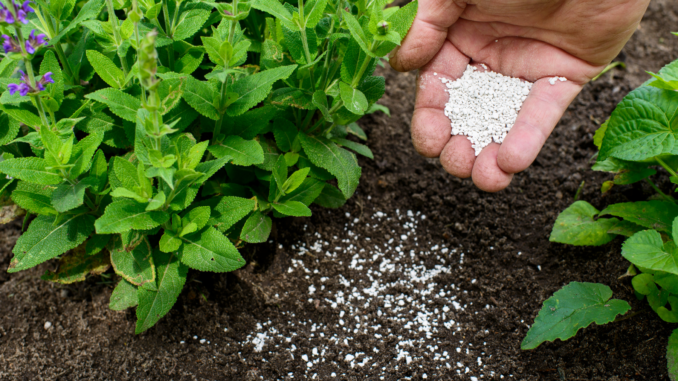
by Kelly Kellow, Horticulturist, Gardens on Spring Creek
Ever heard of the saying “knee-high by the fourth of July”? It is a saying that many farmers use about their corn crop being on track with their growing schedule. If the corn is knee-high by the fourth of July, then the corn is growing at the rate you need it to in order to get a good amount of crop in the fall. Now, this saying may work for corn, but does it work for other vegetables in the garden? Have you ever wondered, “Is my plant on the right schedule? If not, how do I get to where it needs to be?”
One question I always ask to garden if they are struggling with their crops is “have you fertilized”? It is one of the most important aspects of gardening to get large, bountiful plants and produce.
Adding compost, leaves, manure, or other materials to the soil is good for the soil and plants alike. However, in time, nutrients get washed away and taken up by microorganisms, leaving your plants with little to no sustenance. That is when fertilizing comes in handy to supplement plants with nutrients they are lacking. Through fertilizing, you are giving the plants what they need, and you can also manipulate them to grow bigger and start blooming or fruiting – a win / win!
So, when should you start fertilizing? Fertilize first s soon as you have planted your crop, whether it’s right after the frost date or before the first day of summer. This gives plants a boost of nutrients for them to start growing instead of sitting stagnant waiting for something to happen. How often you fertilize is up to you – usually, once a week or every other week is sufficient.
An important factor when fertilizing is to always read the label. This will tell you how often and how much you should be applying to your plants. You never want to over-fertilize, as that can create problems in the soil and with plants that have insects or leaf burn, often leading to death. Not all plants do well with fertilizers, so double check to see if your crop can handle extra nutrients.
There are many fertilizers in the trade, so which to use is up to you. There are many types of organic and synthetic fertilizers and non-traditional fertilizers that work just as well as name brands. For example, Epsom salt is great for greening up leaves, while bat guano is high in nitrogen making it suitable for growing large plants. You can also switch between fertilizers to give plants an array of nutrients to grow big or bloom more – whatever your fancy!
Be sure to fertilize throughout the season. At the beginning of the growing season, it’s always best to use a fertilizer with a high nitrogen formula. This will help get the plants to mature in size in order to hold the fruit they will bear. Say your crop was planted in May, usually, nitrogen fertilizer is best until mid-July. From then, switch to a high-potassium fertilizer for the rest of the growing season to promote blooming. This will help the plant continue to bloom even after you have harvested fruits off of the plant.
Coming up with a fertilizing program in your garden will not only give you boisterous plants but plentiful produce for you to enjoy all year long!
Support Northern Colorado Journalism
Show your support for North Forty News by helping us produce more content. It's a kind and simple gesture that will help us continue to bring more content to you.
BONUS - Donors get a link in their receipt to sign up for our once-per-week instant text messaging alert. Get your e-copy of North Forty News the moment it is released!
Click to Donate
